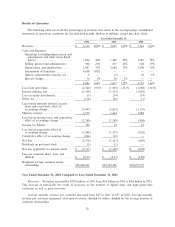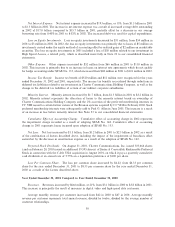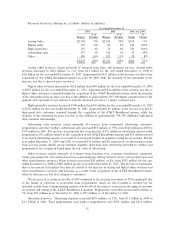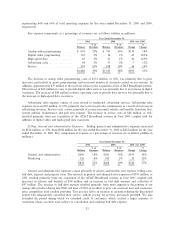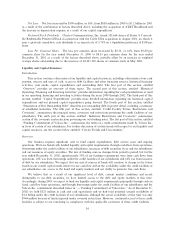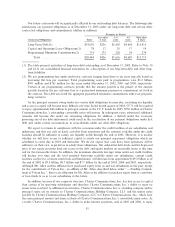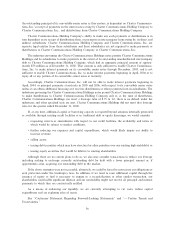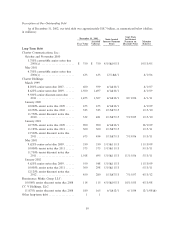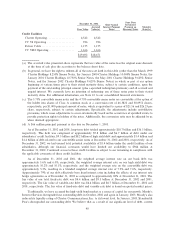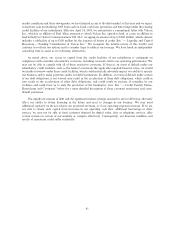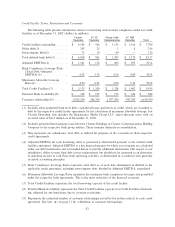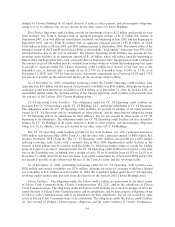Charter 2002 Annual Report Download - page 38
Download and view the complete annual report
Please find page 38 of the 2002 Charter annual report below. You can navigate through the pages in the report by either clicking on the pages listed below, or by using the keyword search tool below to find specific information within the annual report.the outstanding principal of its convertible senior notes as they mature, is dependent on Charter Communica-
tions, Inc.'s receipt of payments on the mirror notes owing by Charter Communications Holding Company to
Charter Communications, Inc., and distributions from Charter Communications Holding Company.
Charter Communications Holding Company's ability to make any such payments or distributions is in
turn dependent on its receipt of distributions from, or payments on intercompany loans owing by, its direct and
indirect subsidiaries. Charter Communications Holding Company and Charter Communications, Inc. are
separate legal entities from these subsidiaries and these subsidiaries are not required to make payments or
distributions to Charter Communications Holding Company or Charter Communications, Inc.
The indenture governing the Charter Communications Holdings notes permits Charter Communications
Holdings and its subsidiaries to make payments to the extent of its outstanding unsubordinated intercompany
debt to Charter Communications Holding Company, which had an aggregate principal amount of approxi-
mately $73 million as of December 31, 2002. That amount is only suÇcient to enable Charter Communica-
tions, Inc. to make interest payments on its convertible senior notes through December, 2003, and is not
suÇcient to enable Charter Communications, Inc. to make interest payments beginning in April, 2004 or to
repay all or any portion of its convertible senior notes at maturity.
Accordingly, Charter Communications, Inc. will not be able to make interest payments beginning in
April, 2004, or principal payments at maturity in 2005 and 2006, with respect to its convertible senior notes
unless it can obtain additional Ñnancing or it receives distributions or other payments from its subsidiaries. The
indentures governing the Charter Communications Holdings notes permit Charter Communications Holdings
to make distributions to Charter Communications Holding Company only if, at the time of distribution,
Charter Communications Holdings can meet a leverage ratio of 8.75 to 1.0, there is no default under the
indentures and other speciÑed tests are met. Charter Communications Holdings did not meet that leverage
ratio for the quarter ended December 31, 2002.
If, at any time, additional capital or borrowing capacity is required beyond amounts internally generated
or available through existing credit facilities or in traditional debt or equity Ñnancings, we would consider:
‚ requesting waivers or amendments with respect to our credit facilities, the availability and terms of
which would be subject to market conditions;
‚ further reducing our expenses and capital expenditures, which would likely impair our ability to
increase revenue;
‚ selling assets;
‚ issuing debt securities which may have structural or other priorities over our existing high-yield debt; or
‚ issuing equity securities that would be dilutive to existing shareholders.
Although there are no current plans to do so, we also may consider transactions to reduce our leverage
including seeking to exchange currently outstanding debt for debt with a lower principal amount or, if
opportunities arise, acquiring our outstanding debt in the market.
If the above strategies were not successful, ultimately, we could be forced to restructure our obligations or
seek protection under the bankruptcy laws. In addition, if we need to raise additional capital through the
issuance of equity or Ñnd it necessary to engage in a recapitalization or other similar transaction, our
shareholders could suÅer signiÑcant dilution and our noteholders might not receive all principal and interest
payments to which they are contractually entitled.
As a means of enhancing our liquidity, we are currently attempting to cut costs, reduce capital
expenditures and are exploring sales of assets.
See ""Cautionary Statement Regarding Forward-Looking Statements'' and ""Ì Certain Trends and
Uncertainties.''
36


